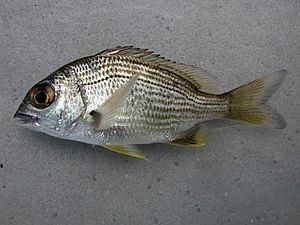Yellowfin bream facts for kids
Quick facts for kids Yellowfin bream |
|
|---|---|
 |
|
| Conservation status | |
| Scientific classification | |
| Kingdom: | |
| Phylum: | |
| Class: | |
| Order: | |
| Family: |
Sparidae
|
| Genus: |
Acanthopagrus
|
| Species: |
A. australis
|
| Binomial name | |
| Acanthopagrus australis Günther, 1859
|
|
| Synonyms | |
|
Chrysophrys australis Günther, 1859 |
|
The yellowfin bream (scientific name: Acanthopagrus australis) is a type of fish. It belongs to the porgy family, called Sparidae. People also call it the sea bream, surf bream, silver bream, or eastern black bream. This fish lives in both salty ocean water and fresh river water.
Yellowfin bream have a deep body. Sometimes, people confuse them with the black bream. But you can usually tell them apart by their yellowish bottom fins (ventral and anal fins). This fish is very popular with people who enjoy fishing. It's known for putting up a good fight when caught. Plus, it tastes great!
Contents
What is the Yellowfin Bream?
The yellowfin bream is one of 20 species in the Acanthopagrus group. This group is part of the porgy family called Sparidae.
How Did the Yellowfin Bream Get Its Name?
The yellowfin bream has had a few different scientific names over time. A scientist named Richard Owen first mentioned it in 1853. He called it Chrysophrys australis. Later, in 1859, a German-British scientist named Albert Günther officially described the fish. He used Owen's name for it.
In 1949, another scientist, Ian Munro, reviewed the "silver breams" in Australia. He called this fish Mylio australis. He also found that what people thought was one species was actually two! He named the other species the southern black bream.
Common Names for Yellowfin Bream
This fish has many common names. Some of these names are also used for other similar fish. In the past, it was called sea bream or surf bream during its spawning season. In New South Wales, it was often called black bream. In Queensland, people just called it bream.
Ian Munro gave it the name yellowfin bream. This name is now the preferred name used by the Australian government. It's also the standard name for commercial fishing. The local Eora and Darug people of the Sydney area had their own names for it, like garuma or kururma.
Can Yellowfin Bream Mix with Other Fish?
Sometimes, yellowfin bream can breed with the southern black bream. When they do, they create offspring that can also have babies. This usually only happens in special places, like a coastal lake. If the two fish types are stuck together for a long time, they might interbreed. Their babies will look a bit like both parents. However, this is very rare. It doesn't happen often enough for them to be considered the same species.
What Does the Yellowfin Bream Look Like?
The yellowfin bream grows more slowly than the black bream. It can reach about 23 centimeters (9 inches) long in five years. It becomes an adult when it's about 22 centimeters (8.7 inches) long.
Yellowfin Bream Colors and Size
The color of the yellowfin bream can change. Fish caught in fresh water might look bronze or brown. Those caught in salty river mouths or the ocean are usually more silvery.
Some very large yellowfin bream have been caught. In 1928, a fish measuring 56 centimeters (22 inches) long and weighing over 3 kilograms (7 pounds) was caught in the Georges River. Another one from the Clarence River was even longer, at 58.5 centimeters (23 inches)!
Where Do Yellowfin Bream Live?
Yellowfin bream live along the east coast of Australia. You can find them from Townsville in northern Queensland down to Mallacoota and the Gippsland Lakes in eastern Victoria.
Yellowfin Bream Habitats
These fish live in river mouths (estuaries) where the water is salty or a mix of fresh and salt (brackish). They can also be found in fresh water, right up to where the salt water stops. Near the ocean, they live around rocky reefs and headlands.
Reproduction and Life Cycle
During the spawning season, surf bream swim downstream to river mouths. This is where they release their eggs. The female fish lay tiny eggs that float in the water. These eggs hatch after a few days. The young fish then stay in the river mouths (estuaries) as they grow.
Changing Gender
Yellowfin bream are special because they are "protandrous." This means that male fish can change into female fish after the spawning season.
What Do Yellowfin Bream Eat?
Yellowfin bream are carnivores, which means they eat meat. They hunt small fish and other creatures that live on the bottom of the water.
Yellowfin Bream Diet
Their diet includes crabs, shellfish, and different types of worms. They also like to eat oysters. Because of this, you can often find them swimming around oyster farms.
Fishing for Yellowfin Bream
People catch yellowfin bream for both fun and for selling.
Commercial and Recreational Fishing
Most commercial fishing for yellowfin bream happens in northern New South Wales and southern Queensland. Fishers usually catch them in autumn and winter using nets and traps. People who fish for fun (recreational anglers) are thought to catch twice as many fish as commercial fishers.
Long ago, indigenous Australians also ate surf bream. We know this because their remains have been found in ancient rubbish piles called middens.


